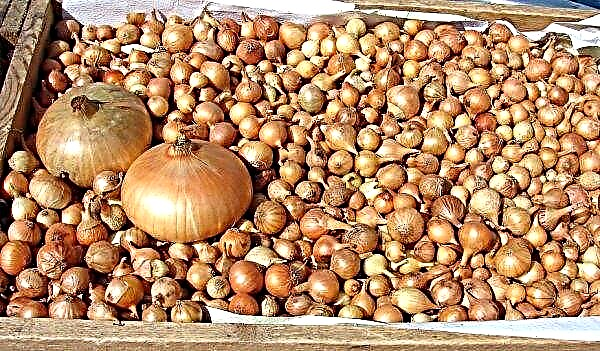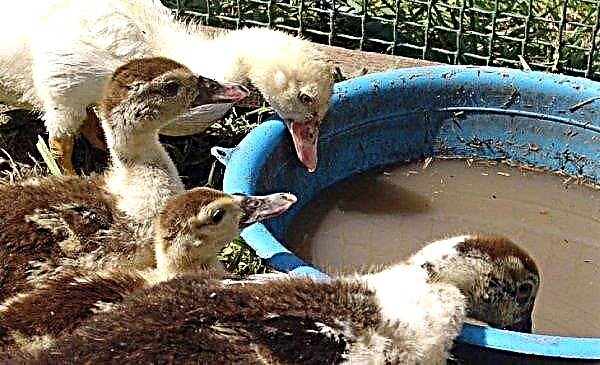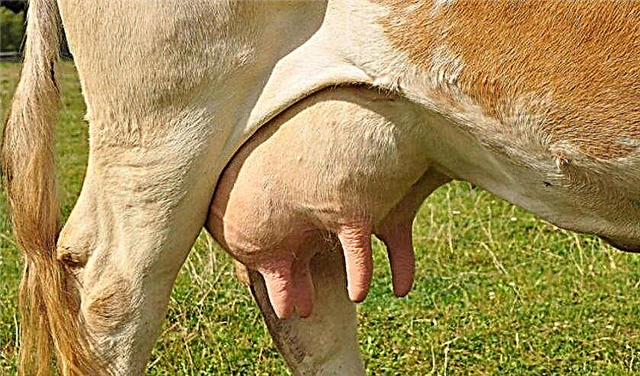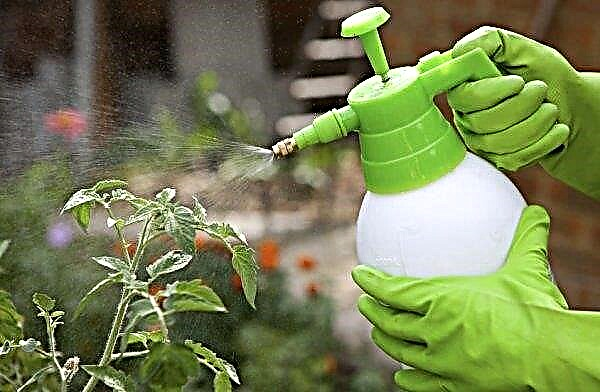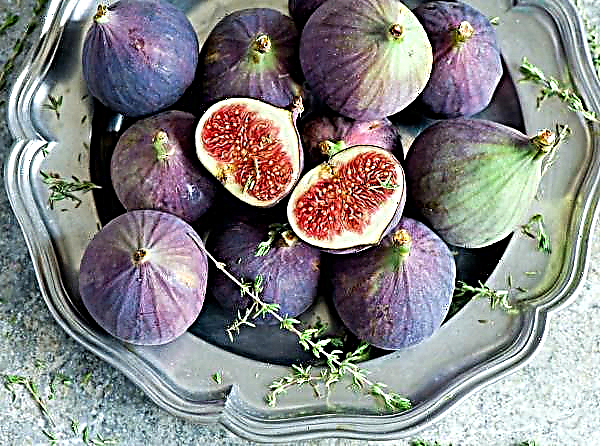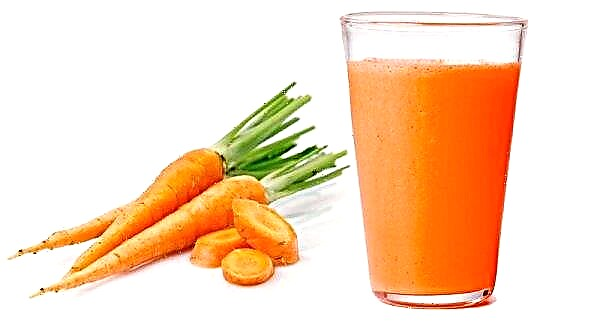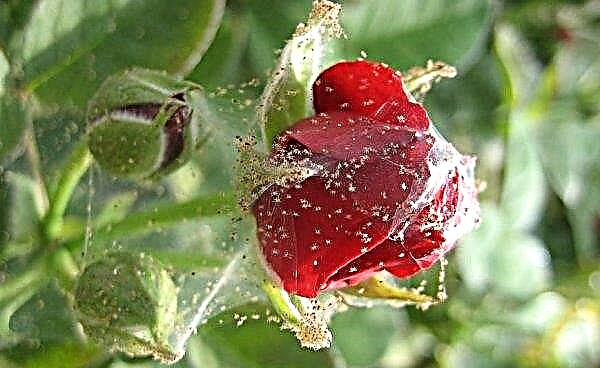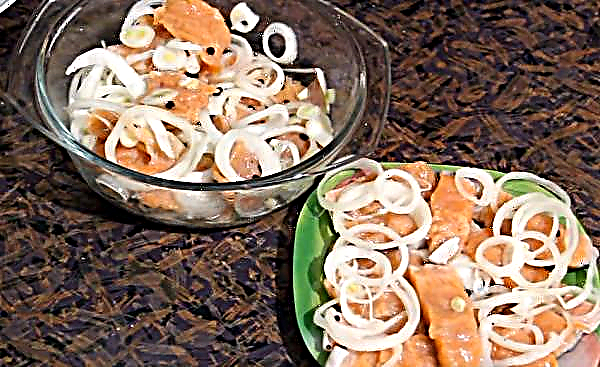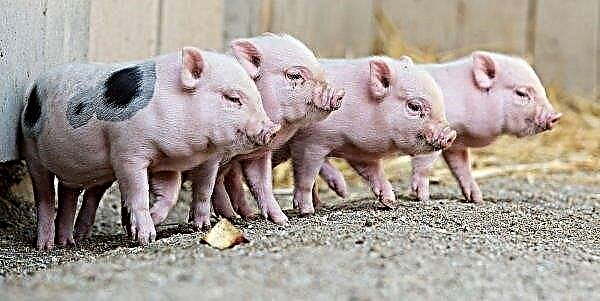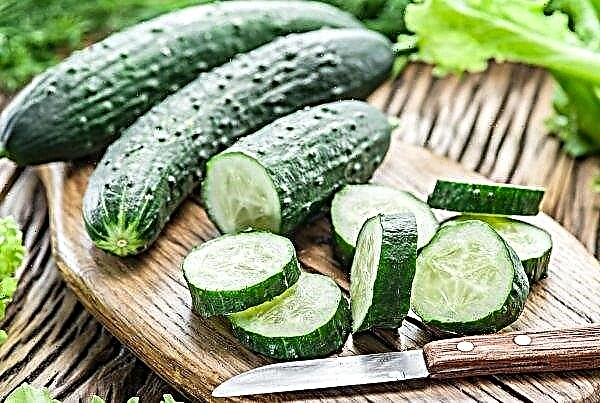I can’t even believe that once a tomato was grown as an ornamental plant and was considered unfit for food. Now a rare garden or summer cottage does without this useful and edible decorative culture. From this material you will learn about the advantages of the tomato variety Grozdeva F1, methods of growing healthy plants from seedlings, methods of harvesting and storage.
History of Variety Breeding
Tomato Grozdeva F1 refers to the hybrid varieties of the first generation, as evidenced by the designation F1 in the title. This variety is the achievement of Russian breeders from the company "Semko"; It was entered in the State Register of the Russian Federation in 2010 and is recommended for cultivation under film shelters not only in the central, but also in the northern regions.
Grozdeva F1 belongs to carpal tomatoes, which are characterized by the setting and ripening of fruits in the form of a bunch. They are more resistant to both diseases and climatic conditions.
This variety also includes:
- French bunch;
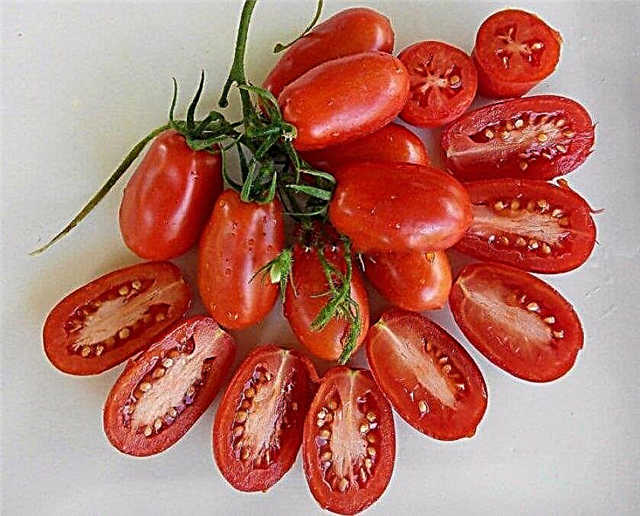
- Black bunch;
Video: French grape tomato
- Siberian bunch.
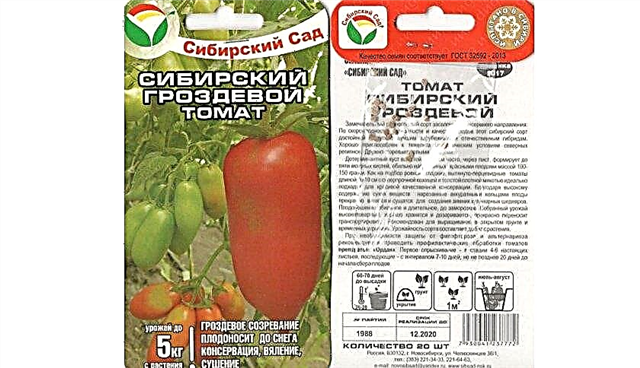
Characterization and description of the variety
Harvest, early ripening hybrid variety of tomato Grozdeva F1 begins fruiting 100-105 days after full germination.
Tomato Grozdeva F1 refers to indeterminate varieties, the growth of which is unlimited, if you do not pinch the top of the stem. Pinching should not be carried out immediately after the brush, but through two real leaves: the presence of these leaves will ensure the maturation of the last bunch. Formed adult bushes are powerful and tall, with a moderate amount of small green leaves and clusters of fruits.
Bunches are formed along the entire height of the stem after every third leaf, quite high, starting from 9–11 leaf. 8-10 fruits ripen in a bunch at the same time. Fruiting is plentiful and long.
The hybrid tolerates drought, is adapted to temperature fluctuations and is suitable for cultivation in areas with short summers. When sowing in early March, ripening occurs in July - under favorable weather conditions and proper agricultural technology.
Video: Tomato varieties Grozdeva F1
The fruits are small, juicy and sweet and sour. The weight and size of the fruit make the variety convenient for salting and whole-fruit preservation. Can be dried, dried, frozen and used fresh in salads.
In the middle and northern latitudes it is better to grow it in a greenhouse. In the southern regions, cultivation in open ground is possible, but the bushes will be less tall, the number of ovaries is less, and accordingly, the yield is lower.
Productivity
Tomato Grozdeva F1 in yield exceeds many samples of domestic and foreign selection. The stability of the crop does not change throughout the cultivation of the variety.
The total yield of the variety is 19.1 kg of tomatoes per 1 m². Productivity can be increased by growing a plant in two stems. It bears fruit from the middle of summer up to frosts.
Did you know? The fruits of wild-growing tomato, found in Latin America, weigh only 1 g, and the weight of cultivated tomatoes reaches 1 kg or more.
Description of the fetus
The fruits of the variety Grozdeva F1 are all even with respect to each other, ripen together, have an oval-elliptical shape with a pointed “nose”. Unripe fruits are light green in color, and when ripe, they acquire a classic bright red color.
The fruits are fleshy, sweet, medium-sized (closer to small-fruited) weighing 85–100 g. The number of seed nests is 2. The skin is dense, which excludes cracking. There is no white frame under the skin.
Fruits tolerate transportation well, without losing their taste.

Advantages and disadvantages of the variety
- The advantage of this variety is to fulfill the basic requirements for this type of vegetables:
- large bushes;
- plenty of fruits;
- the beauty and great taste of tomatoes;
- disease resistance;
- good fresh storage and high marketability.
- The disadvantages, but rather the inconvenience of the variety, include the following:
- Tomato Grozdeva F1 - a hybrid. Seeds must be purchased in specialized stores;
- frequent brush formation requires more fertilizer;
- the plants are tall and have weak stems, possibly lodging under the weight of the fruit, so reliable support and garter are necessary.
Acceptable timing for growing
The timing of sowing tomato seeds should be calculated based on the planned harvesting period, weather conditions and climatic factors of the growing region.
The sowing of tomato seeds of the Grozdeva variety is best done in early March, so that by the end of the spring season the seedlings reach the age of 50-60 days and are ready for transplanting into the ground.
Important! Seed should not be selected for further cultivation. The advantages of the parent plants will inevitably be lost, which will affect the quality and quantity of the crop.
Features of growing varieties
To get a crop, you should consider the features of growing tomatoes.
Growing seedlings
Grozdeva tomato variety is grown in seedlings, but in the southern regions, under favorable conditions, it is possible to plant seeds in the soil by 3-4 cm with further care as usual seedlings. Such seedlings are able to catch up with seedlings and quickly adapt to natural conditions.
It is better to grow seedlings on your own - buying seedlings on the market, you can make a mistake with the variety and bring to the site of plant disease.
Seeds are soaked in potassium permanganate and biostimulants of growth ("Epin"). The depth of seeding prepared for sowing seeds is 1 cm. Seedlings are covered with cellophane or glass and placed in a warm place. The optimum temperature - + 20 ... + 24 ° С ensures the correct growth and development of tomatoes at the initial stage.
When shoots appeared and seedlings got stronger, it is possible to conduct hardening by moving seedlings to a room with a lower temperature, but not lower than + 8 ° С.
Dive and abundantly water the seedlings begin after the appearance of the second leaf. Sprouts dive into looser seedlings, deepening to cotyledon leaves. Seedlings of tomatoes are very elongated, so the containers are removed from a sunny place.
Tillage for planting seedlings
A healthy and strong plant can only be grown in well-cultivated and fertile soil. Landing in uncultivated land threatens infection and pests.
To obtain seedlings of tomatoes, you need to prepare the soil mixture:
- turf land, humus, sand in a ratio of 6: 3: 1;
- peat, sawdust, greenhouse land in a ratio of 1: 1: 2.
Did you know? 60 million tons of tomatoes are produced annually in the world. While bananas - 44 million tons, apples - 36 million tons, oranges - 34 million tons.
15–20 g of ammonium nitrate or carbonite, 50–60 g of superphosphate, 15–20 g of potassium sulfate, and a half-liter can of ash are added to the soil mixture (for every 10 l). Then the soil must be treated with a hot pale pink solution of potassium permanganate, allowed to cool and fill the seedling tank.
To facilitate and accelerate spring work, holes for planting tomatoes can be prepared in the fall directly on the site. Poured into a hole in a bucket of rotted manure, humus and sand. The top taken out of the holes is filled up to the top, 80 g of nitroammophoski and a half-liter can of ash are added. In the center, you can place a peg for future garter stems. The soil frozen over the winter will save plants from diseases and pests.
Seedling Planting Technology
When growing tomatoes, crop rotation must be observed. The best predecessors are cabbage, garlic, legumes, cucumbers, onions, carrots. It is necessary to avoid areas after potatoes, peppers, eggplant, beets.
The plot for planting seedlings should be in a sunny place. Wind and draft are not a hindrance for tomatoes - this provides air ventilation and promotes pollination. But until the seedlings are stronger, it should be protected from the weather and the bright sun.
You need to plant seedlings in a permanent place in the evening or in cool weather.
The scheme of planting seedlings is 40-60 cm between the sprouts and 70-100 cm in the row-spacing so that neighboring bushes do not overlap each other with foliage. Each plant needs for the full development of a sufficient amount of light and full ventilation. Shading can cause tomato diseases.
In order to avoid damage to the roots, transplantation into the soil should be carried out by transshipment with deepening to the first leaves. Overgrown seedlings can be placed horizontally in the hole, which contributes to the formation of additional lateral roots.
Important! If you shorten the central root of the seedling by a third, you can get a stronger and more extensive root system.
Before flowering, fruit setting and ripening, plantings can be treated with copper-containing preparations.
Features of the care of tomato Grozdeva F1
Tomatoes gratefully respond to proper care and compliance with the rules of agricultural technology.
Watering Rules
Tomato is 93% water and very sensitive to a lack of moisture, so the organization of proper watering is simply necessary:
- Tomatoes do not like water treatments. Excess moisture harms the plant - green mass increases to the detriment of the development of the ovaries in the first inflorescences.
- Watering is carried out with warm water when the soil dries in the morning or evening hours directly under the root, avoiding water entering the stems and leaves.
- Abundantly watering seedlings when planting in the garden, the first seven days they do not water it. The roots deepen in search of moisture and intensively develop - as a result, the plant becomes resistant to drought.
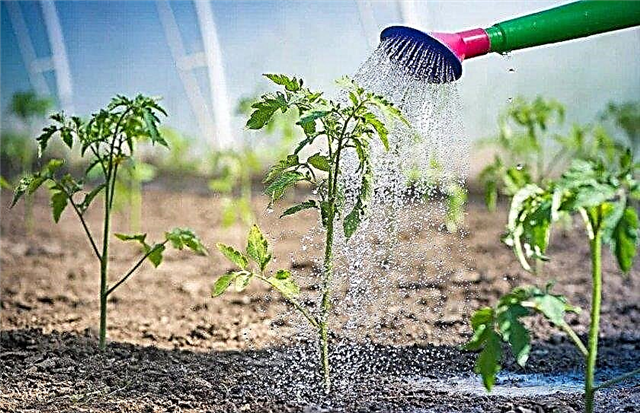
- With the advent of fruits, watering is carried out several times a week, depending on weather conditions. Water consumption during this period can be up to 5 liters per 1 sq. Km. m
- With the irrigation method of irrigation, the water comes closer to the roots and the soil does not compact.
- Drop watering is considered the best way - irrigation is carried out at any time of the day.
- To avoid the tedious work of watering and weeding, to preserve moisture in the upper layer of the soil, you can use the method of mulching with straw, sawdust or a dark film.
Top dressing
Topping tomatoes is done three times during the growing season:
- The first one when planting seedlings in furrows is fertilizers with nitrogen and phosphorus.
- The second two weeks after planting during the flowering of the first brush - fertilizers with nitrogen and potassium.
- The third during the formation of ovaries and ripening of fruits - fertilizers with phosphorus and potassium.

Pasynkovka and formation of a bush
For indeterminate varieties, which include Grozdeva F1, garter and pinching are the main rules of care:
- The plant is formed into one or two stems (the number of stems shortens the ripening period, but increases the yield).
- Once a week, stepsons are removed - not with a knife, but breaking out by hand so as not to damage the stem and leaf. Stepchildren torn at the beginning of the season can be used as a full seedling, rooted in moist soil.
- The abundance of fruits on tall plants can lead to lodging of stems and damage to brushes, so plants need to be tied to trellises or stakes, and the clusters should be supported or supported with twine and wire hooks.
- Leaf removal - healthy leaves from the stems are removed only in case of shading of the plantings, but not more than three at a time, so as not to reduce evaporation through the leaves. Otherwise, excess moisture will go to the fruit, and they will crack. But yellowed and with signs of disease leaves are removed in a timely manner. Removing leaves increases light and air exchange.
- The number of fruits in the brush - the strength of the brush is aimed at ripening all the ovaries. You can get a lot of small fruits, or by removing some, get larger ones.
Did you know? If next to to plant sunflower or corn, then stalks of tomatoes can be tied to their trunks and not look for stakes for garter.
Soil cultivation and weeding
Tomatoes love porous soil, so loosening and weeding are necessary throughout the season. The hilling process is no less important, which strengthens the root system.
Deep first loosening (8-12 cm) contributes to the warming of the topsoil. In the future, loosen to a depth of 4-5 cm.
To save labor costs when watering and loosening will help mulching. Mulch keeps the topsoil moist and inhibits the growth of weeds, and also retains the heat needed by the root system at night.

Grade Diseases and Pests
Variety Grozdeva F1 is declared as resistant to disease, but under adverse conditions and a violation of agricultural technology, the disease can occur.
Plants should be carefully inspected so as not to miss the first signs of the disease:
- the fruits are cracking - differences in day and night temperatures (more than + 20 ° C), top dressing with concentrated nitrogen solutions of young plants or excessive watering;
- thin plants with long internodes, loose flower brush and a small number of fruits - lack of light;
- powerful green mass, twisted leaves and a small number of fruits - lack of light, excess moisture or excess nitrogen fertilizers;
- fruit rot - uneven watering, excess potassium with a lack of calcium (foliar top dressing with calcium nitrate);
- white hardened fruit stains - sunburn with a lack of deciduous mass;
- brown spots on leaves and fruits with deep penetration - late blight (prevention - “Mikosan” and “Pentaphagus”, treatment - Bordeaux fluid, “Tattu” and “Infinito”);
A good way to fight diseases is the joint planting of tomatoes and mustard, basil, calendula, marigold. The pungent smell of these plants will not only scare away the pests, but also improve the taste of the fruit.
We advise you to learn more about tomato diseases:
Basic rules for the collection and storage of crops
The cultivation of any vegetable culture ends with the collection and preservation of the crop.
Tomatoes are harvested as they ripen almost daily, but the longer the fruit is connected to the bush, the better the taste and aroma. Therefore, the collection is best done in clusters or leaving a stalk on a tomato, such tomatoes are stored longer.
It is desirable to collect all the fruits before lowering the night temperatures to + 13 ° C: at this temperature, growth and development ceases. Ripe tomatoes can be stored in cardboard or plastic containers.
Brown and green can be folded into containers in layers, overlaid with paper. In each layer, it is necessary to place a ripe fruit, which will provide faster ripening of brown tomatoes. The container should be covered with dense material and stored at room temperature.
Important! Low temperature destroys volatiles and kills the wonderful aroma of tomatoes, so do not store them in the refrigerator.
Smooth, small and tasty fruits of the Grozdeva F1 variety can be preserved, dried, dried, frozen and used fresh.
So, the variety Grozdeva F1 is an unpretentious and productive variety of tomatoes. By choosing this variety, correctly preparing the beds and observing the rules of cultivation, you can please yourself and loved ones with delicious tomatoes from your garden.





